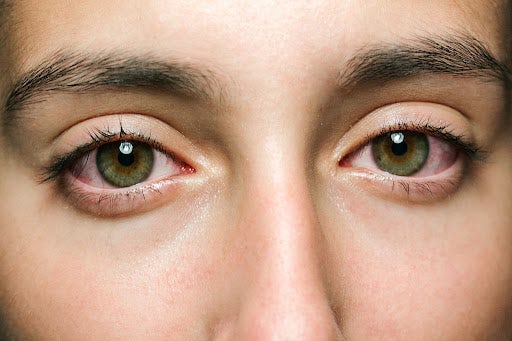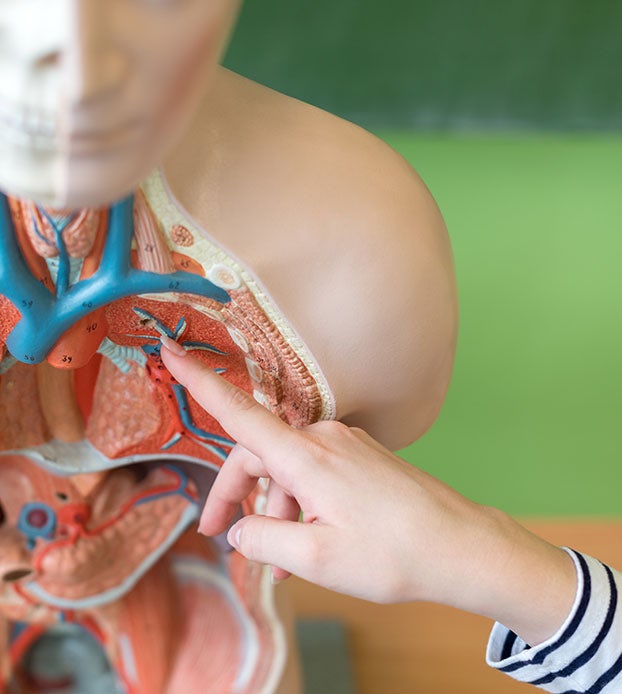Growing up, you probably heard that smoking weed can lower sperm count, make you lazy, and stunt your growth. Happily, we now live in an age of information that means we no longer need to blindly swallow what we hear at school, but there’s still a lot of misinformation – especially when it comes to cannabis.
So is it true? Does consuming cannabis affect growth? Does when you consume it, how, and how much matter?
The short answer, according to the existing scientific research, is maybe, and it depends. To properly answer this question we need to first look at what we know about cannabis and development in general. And we can’t do that without looking at the endocannabinoid system (ECS).
Is the ECS involved in development?
Discovered by scientists in the early 1990s, the endocannabinoid system is responsible for regulating many basic functions throughout the body including mood, appetite and memory.
The system can be activated by cannabinoids that are naturally created by the body — endocannabinoids — along with those found in the cannabis plant — phytocannabinoids. The ECS regulates a host of bodily functions, including memory, appetite, body temperature, the immune system, sleep, pain, and the female reproductive system, many of which overlap with development in some way.
Specifically, the ECS is important for brain and hormone development – from the embryo stage all the way into adulthood. Researchers have noted a complex interplay between the ECS and the hypothalamus, pituitary gland, and the ovarian axis, with CB1 receptors – the primary receptors of the ECS – believed to modulate numerous aspects of physical and sexual development. 1
This means that proper endocannabinoid system function is essential for reproductive success. The role of phytocannabinoids like THC and CBD in pregnancy and breastfeeding, however, remains a point of contention, with concerns that they could disrupt the balance needed for a mother to carry a healthy baby to term. 2 3
As is often the case with cannabis, the research is inconclusive, but there is some evidence to suggest that regular, long-term exposure to cannabinoids, specifically THC, may impede both physical and mental development.
Does adolescent cannabis use stunt growth?
As countries around the world continue to decriminalize and legalize cannabis, cannabis use among teenagers and young adults seems to be on the rise – and with it parental concerns about the impact of early use. 4
Most research to this point has focused on the mental and cognitive effects of THC, rather than physiological effects like impact on hormone levels and subsequent impacts on height and growth. The authors of a 2018 review of the literature, explain that a key component in the pubertal transition “is the production of sex steroids, and perturbation of puberty [which] can have lifelong implications on growth, metabolism, and accrual of bone mass.” So it stands to reason that understanding the implications of cannabis use on the physical health of adolescents is vital to the question of whether weed stunts growth. 5
So here’s what we know, and what we don’t know. It’s not enough to say for sure, but there is some evidence that chronic cannabis use – daily or all-day consumption of THC-rich products – can affect testosterone levels, which can affect the onset of puberty and the associated physical changes. The research is not clear, though, with some studies suggesting that THC increases testosterone levels and others pointing to a decrease in testosterone long term. 6
Does cannabis impact brain development?
Let’s talk neurology. There is some evidence that early and sustained cannabis use can affect attention span. In a 1999 study, adolescent cannabis users (those who started before age 15) underperformed on tests of attention, learning, and memory. Researchers found evidence of reduced motivation in adolescent cannabis users, and that those who used cannabis early “demonstrated poorer performance on tasks of sustained attention, impulse control, and executive functioning.” Researchers also found that subjects who started using cannabis before the age of 15 showed significant impairment in reaction times, whereas users who abstained until after the age of 15 were not affected. 7
Despite concerns about cannabis and cognition, a 2021 review of the evidence found little connection between early cannabis use and negative effects on brain development. This conundrum is best captured in this quote from a 2014 study, Effects of Cannabis on the Adolescent Brain: “There have been considerable additions to the literature over the last decade, yet the degree of impairment related to marijuana use in adolescence remains inconclusive.” 8 9
On a related note, a 2020 study looked at hundreds of pairs of twins, in which one used cannabis and the other didn’t, and concluded that cannabis use doesn’t seem to cause cognitive decline, or correlate with other negative outcomes. The authors of the study postulated that other factors (likely social or environmental) were the cause of a predisposition to a drop in IQ or to using cannabis, rather than the cannabis exposure causing a cognitive decline. 10
Does consuming cannabis during pregnancy and lactation affect fetal growth?
Research on substance use during pregnancy and lactation is notoriously scarce, and it’s easy to understand why – it’s just too risky to intentionally expose mother and baby to potentially dangerous substances, even for the sake of science. And of course this is even more taboo when it comes to mind-altering substances like cannabis. Pregnant and nursing women are usually advised by healthcare providers not to use cannabis at all. Is this because we know it’s detrimental, or because we just don’t know enough?
As discussed, the ECS is integral to creating a healthy environment for the fetus during early pregnancy, playing a significant role in the development of the embryo, its implantation in the womb, the development of the placenta, and the formation of the brain and organ tissue. CB1 receptors appear from as early as 14 weeks gestation. The fact that THC binds with important cannabinoid receptors in the brain, and the fact that THC can pass from the mother through the placenta to the developing fetus indeed raises questions about the safety of exposing an unborn baby to THC. 11
An 2020 international study published followed 5,610 pregnant women with low risk pregnancies and found that mothers who consumed cannabis gave birth to smaller babies. Women who consumed cannabis after week 15 of the pregnancy gave birth to babies with a mean weight of 2.93kg, compared with women who had never used cannabis, who birthed babies with a mean weight of 3.41kg. Women who used cannabis no more than once a week, which is classified as moderate use, did not show this low birth weight effect, giving birth to babies with an average weight of 3.39kg. 12
The study also revealed other findings regarding baby size. Women who were using cannabis at 15 weeks gave birth to shorter babies with smaller head circumferences, who tended to be born earlier. And while smaller babies might sound a little easier to birth, reduced birth weight and size is considered by experts to be a negative neonatal outcome.
A 2022 systematic review and meta-analysis that reviewed data from approximately 5.5 million women corroborated these findings, concluding that cannabis use increased the risk of low birth weight, preterm birth and smallness for gestational age, independent of the effects of other drugs or tobacco. 13
It’s important to note that while these studies suggest that women who use cannabis (particularly those who use it regularly) are more likely to give birth to babies with lower birth weights, the mean birth weights found in the 2020 study still fall within what is considered to be a normal weight range (2.5-4kg). Also, these studies have focused on recreational cannabis use and often relied on the mother’s memory, so there’s no information on dosing, cannabinoid levels, or profiles of products consumed, which were presumably high-THC varieties. Remember – correlation does not (necessarily) equal causation.
What about CBD? Is it safe during pregnancy and lactation?
Depending on health conditions and local regulations, some pregnant patients are trying cannabis-based medicines for multiple ailments. Since CBD doesn’t interact directly with the CB1 receptors, it’s likely to affect the growing fetus in different ways to THC. That said, there is currently very little scientific data available on the effects of CBD during pregnancy, and virtually no human data.
Does consuming cannabis while breastfeeding affect the baby?
How long does cannabis stay in breastmilk? Or in other words, can you pump and dump after consuming? All studies so far have been carried out on THC, and most suggest that THC can be found in breast milk for up to six weeks after regular use. Evidence is scant whether this poses any risk for the baby, although one study found that daily use may slow a baby’s motor development but not cause a cognitive delay. 14
Hopefully this won’t be the case for long – but it’s important to keep in mind that unless you live in one of the few countries in the world where recreational cannabis use is legal, smoking cannabis containing THC during pregnancy or after birth could have serious legal implications if you are caught — both for you and your child.
If you’re a medical cannabis patient and have a prescription from a doctor, you’re likely exempt from these legal issues. However, if you are using cannabis for medical reasons and live in a country where its use is illegal, or you don’t have a medical cannabis prescription, the authorities/child services could become involved if it becomes known you are consuming cannabis while pregnant or breastfeeding, even for medical purposes.
Why is researching cannabis and pregnancy so difficult?
Much research on cannabis exposure in utero relies on self-reported use and surveys. However, this research methodology can be compromised by participants giving more socially acceptable answers rather than truthful responses. Self-reported research can also be limited by participants’ ability to assess themselves accurately, including both personal and cultural biases. 15
Research also often relies on urine tests to identify women who use cannabis while pregnant, which can reliably detect the presence of THC but not when or how much THC was consumed. What’s more, many existing studies don’t identify the delivery method or type of cannabis pregnant women use.
Cannabis can be broadly categorized into three main types: Type I (THC dominant), Type II (balanced THC and CBD), and Type III (CBD dominant). Nearly all studies exploring the effects of cannabis exposure in utero refer generically to mariajuana (Type I or high-THC cannabis), but don’t differentiate or investigate the effects of specific cannabinoids. While THC may affect the developing placenta, it’s less clear how CBD or CBG may affect a fetus, for example.
Research exploring the effects of psychoactive substances on human participants can also be challenging due to confounding factors – unmeasured variables that present during a study, which can influence the supposed cause and effect. Studies on cannabis use during pregnancy often emphasize that it’s unclear the degree to which cannabis contributes to low birth weight in a child whose mother is – for example – also underweight, impoverished, and consumes alcohol regularly.
Does weed stunt muscle development?
Muscle development is another area in which there’s simply not enough research. As mentioned, chronic exposure to cannabis may impact testosterone levels, which can in turn alter growth. But does that include muscle development? And what if you’re past puberty and working on those abs – is cannabis a hindrance or a help? It’s hard to tell.
One thing we can say for sure is that cannabinoids have anti-inflammatory properties – so if you’re looking to use cannabis to improve your performance at the gym, it could be useful for muscle recovery. Additionally we know that cannabis can cause an increase in appetite, which suggests that it could be used for bulking.
However a new study out of University of California, Irvine found that THC exposure in adolescence could affect the way our body uses and stores energy in adulthood. Researchers gave adolescent mice regular doses of THC, and found that they appeared as adults to be leaner and healthier mice. However, a closer look at the metabolic profiles of these adult mice revealed abnormalities, suggesting that the THC exposure had negatively impacted their fatty tissues. This may have a negative impact in the long term. 16
Do edible and topical cannabis products stunt growth?
Many of the downsides of consuming cannabis actually come from smoking – rather than from the plant itself. So if you’re looking to circumvent the potential developmental effects, choosing another way to consume could lower your risks.
Let’s start with edibles. Cannabis-based food products carry cannabinoids too, and like smoking they are delivered systemically. Most likely, the developmental risks are the same as smoking cannabis, but this topic is understudied as most studies use inhaled cannabis.
Topicals, however, are a different story. As long as they’re not transdermal – ie they don’t penetrate the skin – the risks are likely lower. Again, while there’s no research to back this up, we know that high-THC topic products aren’t well absorbed, indicating that they’re unlikely to impact a fetus, for example, or adolescent hormone production.
Less prevalent, innovative delivery methods such as transdermal patches and suppositories are similarly understudied, so the impact is even less clear. While there is some topical effect with both product types, with the first few layers of skin absorbing some cannabinoids, the deeper systemic effect is unknown and variable.
The bottom line on cannabis and growth
The effects of cannabis consumption on growth and development remain complex and inconclusive. While we know that the ECS plays a critical role in various aspects of development, including brain and hormone development, the impact of phytocannabinoids found in cannabis on development is still a point of contention.
Studies suggest that chronic exposure to THC, particularly during adolescence, may potentially impede both physical and mental capacities. Furthermore, cannabis use during pregnancy has been associated with lower birth weight and other negative neonatal outcomes. However, it is important to note that the mean birth weights reported in these studies fell within the normal range, and correlation does not necessarily equal causation. Research on the effects of CBD during pregnancy and lactation is limited, but the conservative recommendation is to discontinue marijuana and hemp products during these periods due to insufficient safety data.
The Cannigma Staff writers contributed to this article
Sources
- Lu, H. C., & Mackie, K. (2021). Review of the Endocannabinoid System. Biological psychiatry. Cognitive neuroscience and neuroimaging, 6(6), 607–615. https://doi.org/10.1016/j.bpsc.2020.07.016
- Mauro Maccarrone (Professor) (2015) Endocannabinoid signaling in female reproductive events: a potential therapeutic target?, Expert Opinion on Therapeutic Targets, 19:11, 1423-1427, DOI: 10.1517/14728222.2015.1062878
- Metz, T. D., & Borgelt, L. M. (2018). Marijuana Use in Pregnancy and While Breastfeeding. Obstetrics and gynecology, 132(5), 1198–1210. https://doi.org/10.1097/AOG.0000000000002878
- Rubin-Kahana, D. S., Crépault, J. F., Matheson, J., & Le Foll, B. (2022). The impact of cannabis legalization for recreational purposes on youth: A narrative review of the Canadian experience. Frontiers in psychiatry, 13, 984485. https://doi.org/10.3389/fpsyt.2022.984485
- Sims, E. D., Anvari, S., Lee, Y., Samaan, Z., Banfield, L., Thabane, L., & Samaan, M. C. (2018). The effect of cannabis exposure on pubertal outcomes: a systematic review. Adolescent health, medicine and therapeutics, 9, 137–147. https://doi.org/10.2147/AHMT.S175864
- Thistle, J. E., Graubard, B. I., Braunlin, M., Vesper, H., Trabert, B., Cook, M. B., & McGlynn, K. A. (2017). Marijuana use and serum testosterone concentrations among U.S. males. Andrology, 5(4), 732–738. https://doi.org/10.1111/andr.12358
- Ehrenreich, H., Rinn, T., Kunert, H. J., Moeller, M. R., Poser, W., Schilling, L., Gigerenzer, G., & Hoehe, M. R. (1999). Specific attentional dysfunction in adults following early start of cannabis use. Psychopharmacology, 142(3), 295–301. https://doi.org/10.1007/s002130050892
- Cawkwell PB, Hong DS, Leikauf JE. Neurodevelopmental Effects of Cannabis Use in Adolescents and Emerging Adults with ADHD: A Systematic Review. Harv Rev Psychiatry. 2021;29(4):251-261. doi:10.1097/HRP.0000000000000303
- Jacobus, J., & Tapert, S. F. (2014). Effects of cannabis on the adolescent brain. Current pharmaceutical design, 20(13), 2186–2193. https://doi.org/10.2174/13816128113199990426
- Ross, J. M., Ellingson, J. M., Rhee, S. H., Hewitt, J. K., Corley, R. P., Lessem, J. M., & Friedman, N. P. (2020). Investigating the causal effect of cannabis use on cognitive function with a quasi-experimental co-twin design. Drug and alcohol dependence, 206, 107712. https://doi.org/10.1016/j.drugalcdep.2019.107712
- Biegon, A., & Kerman, I. A. (2001). Autoradiographic study of pre- and postnatal distribution of cannabinoid receptors in human brain. NeuroImage, 14(6), 1463–1468. https://doi.org/10.1006/nimg.2001.0939
- Grzeskowiak, L. E., Grieger, J. A., Andraweera, P., Knight, E. J., Leemaqz, S., Poston, L., McCowan, L., Kenny, L., Myers, J., Walker, J. J., Dekker, G. A., & Roberts, C. T. (2020). The Medical journal of Australia, 212(11), 519–524. https://doi.org/10.5694/mja2.50624
- Baía, I., & Domingues, R. (2022). The effects of cannabis use during pregnancy on low birth weight and preterm birth: a systematic review and meta-analysis. American journal of perinatology, 10.1055/a-1911-3326. Advance online publication. https://doi.org/10.1055/a-1911-3326
- Schuel, H., Burkman, L. J., Lippes, J., Crickard, K., Forester, E., Piomelli, D., & Giuffrida, A. (2002). N-Acylethanolamines in human reproductive fluids. Chemistry and physics of lipids, 121(1-2), 211–227. https://doi.org/10.1016/s0009-3084(02)00158-5
- Thompson, R., DeJong, K., & Lo, J. (2019). Marijuana Use in Pregnancy: A Review. Obstetrical & gynecological survey, 74(7), 415–428. https://doi.org/10.1097/OGX.0000000000000685
- Lin, L., Jung, K. M., Lee, H. L., Le, J., Colleluori, G., Wood, C., Palese, F., Squire, E., Ramirez, J., Su, S., Torrens, A., Fotio, Y., Tang, L., Yu, C., Yang, Q., Huang, L., DiPatrizio, N., Jang, C., Cinti, S., & Piomelli, D. (2023). Adolescent exposure to low-dose THC disrupts energy balance and adipose organ homeostasis in adulthood. Cell metabolism, S1550-4131(23)00179-1. Advance online publication. https://doi.org/10.1016/j.cmet.2023.05.002
Sign up for bi-weekly updates, packed full of cannabis education, recipes, and tips. Your inbox will love it.

 Shop
Shop Support
Support


















